Also on Facebook
I had planned to aggressively thin 80 acres of 1996 loblolly and under plant with longleaf, but the talks I listened to today were not encouraging. The main problem seems to be that loblolly are prolific seed producers and in what essentially remains a loblolly forest, the longleaf cannot compete. I have managed to keep my five acres of longleaf reasonably clear of loblolly by whacking literally hundreds of loblolly, but I will be unable to do that on 80 acres. It is hard enough to keep up with the five.
Another of the talks was about using herbicides to help establish longleaf. Herbicides have evolved and now some can be used very precisely to affect only particular plants. When you cannot burn regularly, herbicides can provide a serviceable alternative.
You need be careful, however. The beauty of the longleaf ecology is in the TOTAL system, not only the trees. It is important to maintain and enhance the herbaceous plants, grasses, wildflowers and forbs. There is a little trade-off. The ecosystem approach will produce slightly less wood, so profit margins are a bit lower. Beyond that, it takes more work and greater care to ensure diversity. It is easier just to knock out everything except the trees but that is just not right. I alluded to that in my earlier post about raking pine straw. If you are going to manage a forest, you want to manage a forest in all its diversity and not just a bunch of sticks and needles.
The diverse forest also supports lots of wildlife, game and non-game species.
It has become fashionable to discuss “ecological services.” This puts an estimate of the dollar value of an ecosystem. For example. a forest protects soil and water resources and provides recreation. All these things would cost money to duplicate. In the case of water, those costs would be very high indeed. I use the “ecological services” argument and consider it valid. But it is not the end. In the final analysis, there is no final analysis. A diverse, sustainable and thriving ecology is an end in itself. It has its own value and it not merely a means of creating value in other things.
The thing I love about forests is their complexity. I know that I can never understand more than only a little and that my brief moment of stewardship is the proverbial dust in the wind. I appreciate it precisely because it is complex and impossible to control in detail.
My trees will still be there, I hope at least, long after I am gone. And the ecological system that they nurture will be there long after they are gone. It is really very wonderful and goes well beyond the ecological services it supplies today and tomorrow.
My first picture is an old one that I have used before. I took it in 2009. It shows the kind of open woods attractive to lots of wildlife and specifically bobwhite quail. Next are ponderosa pines I saw in New Mexico and finally pines in the Sand Hills in Carolina. You can see the kind of thing I am looking encourage. Pine savannas are very pleasant and productive ecology.



